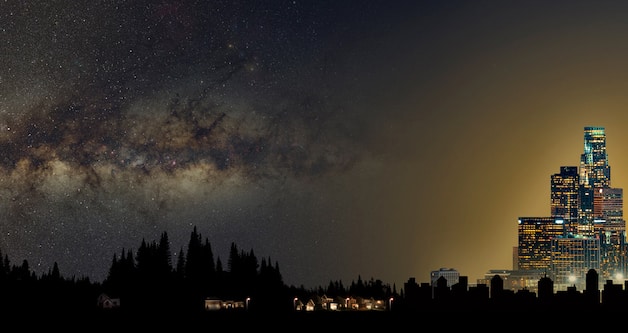According to this, the night sky brightness increases by around 9.6 percent per year worldwide – this is significantly more than assumed on the basis of satellite data. One of the reasons for this could be the increasing switch to LEDs with shorter wavelength light, as the team reports in “Science”.
Man turns night into day: the lighting of streets, buildings and industrial plants not only brightens up the surroundings, but also the night sky. As a result, the night is almost nowhere in the world really dark, around 80 percent of humanity lives under an unnaturally bright night sky. Even telescopes in dark, remote locations are now struggling with light pollution.
This has implications for astronomy, but also for our health and nature: it disrupts reproduction, prey capture and migration of many animals, and pollination of plants by nocturnal insects, among other things. Measures against light pollution have therefore already been introduced in many countries – street lamps are more heavily shielded, and many orange sodium vapor lamps have been replaced by more economical LED lamps.
However, it was previously unclear whether these measures have reduced the scattered light – because it is difficult to measure. “The only satellites that can currently monitor the entire earth for scattered light have limited resolution and sensitivity and cannot detect light with wavelengths below 500 nanometers,” explain Christopher Kyba from the German Research Center for Geosciences Potsdam (GFZ) and his colleagues. As a result, the short-wave light of the white LEDs escapes the satellites.
But there is an alternative: the citizen science project “Globe at Night”, which has been running since 2006. In it, volunteers observe the night sky and then use an app or an online form to indicate which of eight star maps best matches what they see in the sky. The maps show the sky at different levels of light pollution and with correspondingly more or less visible stars. “The contributions of the individual people work together like a global sensor network that enables us to take a completely new approach to research,” says Kyba.
For their study, he and his team have now evaluated the data from more than 51,000 such observations made under cloudless skies from 2011 to 2022. They represent 19,262 locations worldwide, most of them in North America and Europe. From this data and a global model, the researchers determined the brightness of the sky and how it has changed in recent years.
The result: the nocturnal scattered light has not decreased, but has increased dramatically over the last ten years. In Europe, diffuse sky brightness at night has increased by around 6.5 percent per year, and in North America by as much as 10.4 percent, the data revealed. On average worldwide, the increase in scattered light is around 9.6 percent per year. That is almost five times more than previously determined by satellite measurements.
Especially in densely populated regions, the nights are getting brighter rapidly – the starry sky is being visibly outshined. “This means that over the course of an 18-year childhood, the night sky brightens by a factor of four,” explain Kyba and his colleagues. “If evolution progresses like this, a child born in a place with 250 visible stars will only be able to see 100 stars there by the time they turn 18.”
The team attributes the difference between the observational data and satellite measurements to several factors. One is the direction of propagation of the scattered light: “Satellites are most sensitive to light that’s directed upward toward the sky,” explains Kyba. “But it’s horizontally emitted light that accounts for most of the sky’s glow. So if advertisements and streetlights become more frequent, bigger or brighter, they could have a big impact without being adequately reflected in the satellite imagery.”
A second factor is the switch from sodium vapor lamps to LEDs: “Because human eyes are more sensitive to short-wave light at night, LEDs have a major impact on our perception of the brightness of the sky,” says Kyba. “This could therefore also be a reason for the discrepancy between satellite measurements and the observations made as part of ‘Globe at Night’.”
The researchers draw two main conclusions from their results: On the one hand, light pollution in the night sky has continued to deteriorate rapidly despite – or perhaps because of – the switch to LEDs. “On the other hand, we were able to demonstrate that the Citizen Science data represent an important addition to the previous measurement methods,” says Kyba. He and his team hope that more people will get involved in the “Globe at Night” project in the future.
Because up to now there is very little data from poorer and less densely populated regions of the world. “If we had broader participation, we could identify trends for other continents and possibly even for individual states and cities,” says co-author Constance Walker of NOIRLab in Arizona. “The project is ongoing, so feel free to check it out tonight and tell us what you see!” (Science, 2023; doi:10.1126/science.abq7781)
Source: National Optical-Infrared Astronomy Research Laboratory (NOIRLab), Helmholtz Center Potsdam – GFZ German Research Center for Geosciences
This article was written by Nadja Podbregar
Since the firecracker riots sparked the dispute over youth violence and migration, one person has been under particular observation: Martin Hikel, the mayor of the disreputable Neukölln. FOCUS accompanied the young local politician for a day.
The Greens are getting more and more in need of explanation. The reasons: the climate protests in Lützerath and the new RWE deal. On Wednesday evening, the new Federal Defense Minister Boris Pistorius (SPD) first ordered an examination of the stocks of Leopard tanks for a possible delivery to Ukraine on Friday. A report now reveals that his predecessor Christine Lambrecht is said to have banned this within the ministry shortly before.
The original to this post “Barely any stars visible: night sky is rapidly getting brighter” comes from scinexx.















